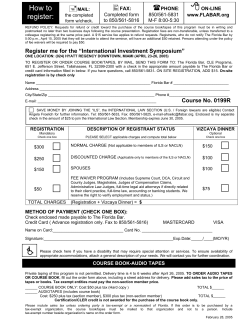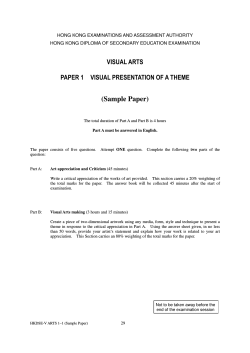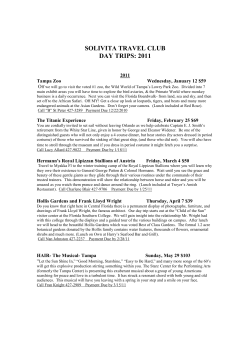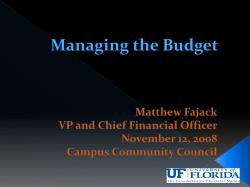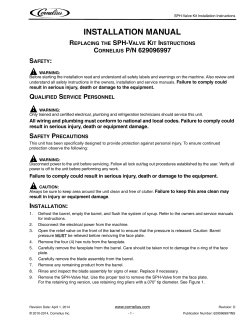
- Earth Science – MacMillan, 1986 – Organization
Florida Science Fusion, New Energy For Earth Science, Holt McDougal 2012 Regular Middle School Science Course Earth Science – MacMillan, 1986 – Grades 6-8 Organization Unit 1 – What Earth Science Is - Chapter 1, What is science - Chapter 2 basics - Chapter 3 problem solving Unit 2- Earth’s Atmosphere - Chapter 4 Observing Weather - Chapter 5 Energy and Atmosphere - Chapter 6 Water in Atmosphere - Chapter 7 Winds and Weather Unit 3 – Earth’s Waters - Chapter 8, Earth’s fresh water - Chapter 9 Oceans Unit 4 - Earth’s Surface - Chapter 10 Minerals - Chapter 11 Rocks - Chapter 12 weathering and soil, - Chapter 13 erosion and deposition Unit 5 – Earth’s Interior - Chapter 14 Movements of Earth’s Crust - Chapter 15 Earthquakes - Chapter 16 Volcanoes - Chapter 17 –Plate Tectonics Unit 6- Earth’s History - Chapter 18 Measuring Geologic Time - Chapter 19 –Earth’s Past Unit 7 – Earth In Space - Chapter 20 An orbit system: Sun, Earth, and Moon - Chapter 21, The solar system - Chapter 22, Stars, galaxies and the universe, Organization Unit 1 – Nature of Science - Lesson 1 Scientific Knowledge - Lesson 2 Scientific Investigations - Representing Data Unit 2 – The Universe - Lesson 1 Structure of the Universe - Lesson 2 Stars Unit 3- The Solar System - Lesson 1 Historical Models of the Solar System - Lesson 2 Gravity and the Solar System - Lesson 3 The Sun - Lesson 4 The terrestrial Planets - Lesson 5 The gas giant planets - Lesson 6 Small bodies in the solar system Unit 4- Earth, Moon, Sun, System - Lesson 1 Earth’s Days, Years and Seasons - Lesson 2 Moon Phases and Eclipses - Lesson 3 Earth’s Tides Unti 5- Space Exploration - Lesson 1 Images from space - Lesson 2 Technology for Space Exploration - Lesson 3 Space Exploration and Florida Unit 6- Earth’s Structures - Lesson 1 Minerals - Lesson 2 The Rock Cycle - Lesson 3 Earth’s Layers - Lesson 4 Plate Tectonics - Lesson 5 Mountain building - Lesson 6 Earthquakes - Lesson 7 Volcanoes Unit 7- Earth’s History - Lesson 1 Geologic change over time - Lesson 2 Relative Dating - Lesson 3 Absolute Dating Unit 8- Weathering, Erosion, Deposition and Landforms - Lesson 1 Weathering - Lesson 2 Erosion and Deposition by Water - Lesson 3 Erosion and Deposition by Wind, Ice and Gravity - Lesson 4Landforms and Florida Unit 9 – Human Impact on Earth Lesson 1 Natural Resources Lesson 2 Human Impact on Land Lesson 3 Human Impact on Water Lesson 4 Human Impact on the Atmosphere Lesson 5 Protecting Earth’s Water, Land and Air Unit 10 – Energy in Earth - Lesson 1 Earth’s Spheres - Lesson 4 Wind in the Atmosphere - Lesson 2 The Atmosphere –Lesson 5 Ocean Currents - Lesson 3 Energy Transfer Unit 11- Weather and Climate Lesson 1, The Water Cycle, Lesson 2 Elements of the Weather, Lesson 3 What Influence Weather, Lesson 4 Severe Weather and Weather Safety, Lesson 5 Natural Disasters in Florida, Lesson 6 Climate General Differences Earth Science – MacMillan, 1986 – Grades 6-8 - Human activities in relation to earth science is only covered in about 8 pages of the whole book - Space is covered in One Unit (less than 100 pages) - The book in its entirety is 579 Pages - The book is hard cover, and glossy pages - No mention of benchmark standards or standardized testing - Lots of text with pictures only either at the side of the bottom Florida Science Fusion, New Energy For Earth Science, Holt McDougal 2012 Regular Middle School Science Course - An entire unit is dedicated to human impact - Space and Space Exploration takes up 4 units (220 pages roughly) - The book in its entirety is 717 pages plus an additional 62 reference pages - The book is soft cover, and pages can be torn out- it’s even referenced as an ‘interactive copy’ (there are many sections where you can write on the pages like a work sheet) - Sunshine State Standards are listed very prevalently throughout the book - Pictures and graphics scattered throughout, much more visually stimulating book – less actual ‘text’ Specific Subject Area Differences Earth Science – MacMillan, 1986 – Grades 6-8 Hurricanes- Powerful Cyclones that form over the ocean in tropical air Other than definition and basics, no storm prep information Plate Tectonics – Discusses Continental Drift, Sea Floor Spreading as ‘earlier theories’ Florida Science Fusion, New Energy For Earth Science, Holt McDougal 2012 Regular Middle School Science Course Hurricane- Tropical low-pressure system with winds blowing at speeds of 199 km/h or morestrong enough to uproot trees. There is also quite a bit of storm preparation language in the text re: hurricanes Plate Techtonics- Calls it a “New Theory” that draws on all ‘three theories’ Makes just a small mention that ‘the currents in the mantle may cause some plates to move” - Discusses divergent and convergent boundaries in detail – but not many photos - Describes Pangea and the historic landmasses prior to defining Plate Techtonics, also disccuses sea floor spreading and even ocean trenches before defining the Plate Techtonic theory. Larger pictures and models to describe tectonic plates & lithosphere, convergent boundaries, transform boundary Discusses ridge push, slab pull and Mantel Convection – describes with graphical photos
© Copyright 2025









